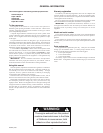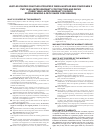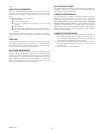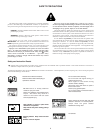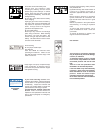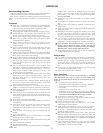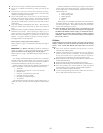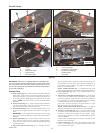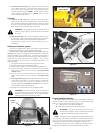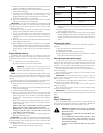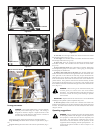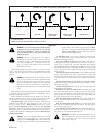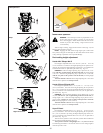
Safe Operating Practices
Some of the following safety instructions are from ANSI Standard B-
71.4-1999 while others are specific to the Hustler Mid Mount Z line.
This product is capable of amputating hands and feet and throwing
objects. Always follow all safety instructions to avoid serious injury or
death.
Operation
▲
Never leave a running machine unattended. Always disengage deck
clutch, place control levers in park brake position, stop tractor
engine, and remove ignition key when leaving operator’s seat.
▲
Always remain seated while operating machine.
▲
Always keep safety shields and covers in place, except for servicing.
▲
Always maintain a safe distance from people and pets when
mowing. Always stop machine if someone enters the area.
▲
Always operate machine in daylight or with adequate working lights.
▲
Follow daily and weekly checklists, making sure hoses are tightly
secured and bolts are tightened.
▲
Always observe traffic laws while driving machine from one
location to another. Watch for traffic when operating near or
crossing roadways.
▲
Always be alert for hazards such as rocks, metal objects and other
debris which may be thrown or entangled by mower blades. Watch
out for holes or deep depressions.
▲
Inspect area to be mowed for hazards such as rocks, metal objects
and other debris which may be thrown or entangled by mower
blades. Remove these objects before mowing.
▲
Always inspect machine for damage after striking a foreign object. If
damage is found, repair machine immediately. Be sure to disengage
deck clutch, place control levers in park brake position, stop tractor
engine, and remove ignition key when leaving operator’s seat to
inspect damage.
▲ Always wear adequate ear protection, such as earplugs, when
operating this equipment as prolonged exposure to uncomfortable or
loud noises can cause impairment or loss of hearing. Do not wear
radios or music headphones while operating the machinery. Safe
operation requires your full attention.
▲ Do not operate the equipment while wearing sandals, tennis shoes,
sneakers, shorts or any type of loose fitting clothing. Always wear
long pants, safety glasses, ear protection and safety shoes when
operating this machine.
▲
Always be aware of what is behind the machine before backing up.
Do not mow in reverse unless absolutely necessary. Always look
down and behind before and while backing up.
▲
Never push forward suddenly on your control levers while the
machine is in rearward motion because machine may tip backwards.
▲
Never pull back suddenly on your control levers while the machine
is in forward motion.
▲
When moving in reverse, push forward slowly on control levers and
avoid sudden movement. Rapid movement of the control levers in
either direction could result in a reaction of the tractor that can cause
serious injury.
▲
Never operate a poorly maintained machine.
▲
Never attempt high speed maneuvering, especially in crowded or
congested areas.
▲
Never allow persons to operate this machine without proper
instruction or allow children to operate machine. Allow only
responsible adults who are familiar with these instructions to operate
this machine.
▲
Never put hands or feet under any part of the machine while it is
running.
▲
Never carry passengers.
▲
Always disengage the blades and wait for them to stop before
crossing gravel drives, walks or roads.
▲
Always keep clear of the mower blades and attachments during their
operation.
▲
Turn off blades when not mowing.
▲
Slow down before turning.
▲
Stop the engine before removing the grass catcher or unclogging the
discharge chute. Never clear the discharge chute with the engine
running. Turn off the engine and be sure the blades have stopped
before cleaning. Use a stick to clear a plugged discharge area.
Never use your hand!
▲
Always keep clear of the mower blades and attachments during
operation.
▲
Do not operate the machine while under the influence of alcohol or
drugs.
▲
Exercise caution when loading or unloading the machine onto a
trailer or truck.
▲
Always wear safety goggles or safety glasses with side shields when
operating the mower.
▲
Data indicates that operators, age 60 years and above, are involved
in a large percentage of riding mower-related injuries. These
operators should evaluate their ability to operate the mower safely
enough to protect themselves and others from serious injury.
▲
If any attachment or additional weight is mounted on the rear of the
unit, any rapid movement of the control levers in either direction
could result in a reaction of the tractor that can cause serious injury.
▲▲
Clean flammable material from machine. Prevent fires by
keeping engine compartment, battery, fuel line, fuel tank and
operator’s station clean of accumulated trash, grass clippings,
and other debris. Always clean up spilled fuel and oil.
▲
Always buckle seat belt, if provided with one, and only if a ROPS is
installed properly, before starting tractor.
Using a ramp
▲
Use extreme caution when loading and unloading a unit with a ramp.
▲
Use only a single, full width ramp; do not use individual ramps for
each side of the unit. Having a full width ramp provides a surface
for the tractor frame to contact if the unit starts to tip backwards. It
also reduces the risk of a wheel going off and the machine tipping
over.
▲
Do not exceed a 15 degree angle between the ramp and the ground
or between the ramp and the trailer or truck.
▲
When on a ramp avoid sudden acceleration
Slope Operation
Slopes are a major factor in loss-of-control and tip-over accidents,
which can result in severe injury or death. All slopes require extra
caution. If you cannot back up the slope or if you feel uneasy on it; do
not mow it.
▲
Use extreme caution when operating on slopes.
• Be extremely careful changing directions on a slope. Slow down.
• Do not operate where the machine could slip or tip.
• Turn slowly
• Turn on the most level part of the slope
• To maximize traction, it is better to turn the front of the machine
uphill, rather than downhill. If drive tires lose traction, steering
control is lost which could cause serious injury or death.
▲
Do not remove or modify the stabilizer wheels.
▲
Watch for holes, ruts or bumps. Uneven terrain could overturn the
machine. Tall grass can hide obstacles.
▲
Remove obstacles such as rocks, tree limbs, etc.
▲
Keep all movement on slopes slow and gradual. Do not make
sudden changes in speed or direction.
▲
Avoid starting and stopping on a slope. If tires lose traction,
disengage the blades and proceed slowly straight down the slope.
▲
Do not turn on slopes unless necessary, and then, turn slowly and
gradually downhill, if possible.
▲
Mow a safe distance (minimum of two mower widths) away from
drop-offs, retaining walls, drainage ditches, steep banks, water, and
other types of hazards to avoid a wheel dropping over the edge or to
avoid the ground from breaking away. This will help avoid machine
rollover and serious injury or death.
▲
Use a walk behind or push mower on slopes and near drop-offs,
retaining walls, drainage ditches, steep banks and water to avoid
machine rollover and serious injury or death.
OPERATION
600876_0706
9



